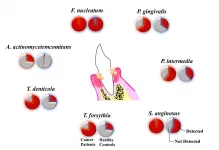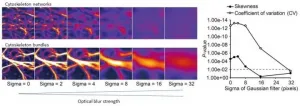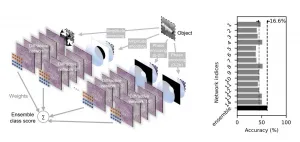Esophageal cancer patients show abundance of oral pathogens
2021-01-14
(Press-News.org) Researchers led by Tokyo Medical and Dental University (TMDU) find that certain oral pathogens are more prevalent in esophageal cancer patients, and could be used as a novel diagnostic tool
Tokyo, Japan - It is increasingly clear that the trillions of bacteria that make themselves at home in and on the human body are more than just casual observers along for the ride. Gut bacteria in particular have been shown to have an enormous influence on human health, with studies suggesting they play a role in illnesses ranging from autoimmune disorders to anxiety and depression.
The oral cavity is another rich source of microbial diversity, with more than 700 bacterial species making our mouths their home. The vast majority of these species are harmless, but a select few cause conditions such as gingivitis, periodontitis, and abscesses. While the role of these pathogens in periodontal disease is well-characterized, more recent studies have hinted at involvement in gastric and esophageal cancers.
In a recent issue of Cancer, researchers led by Tokyo Medical and Dental University (TMDU) characterized the oral bacterial communities of esophageal cancer patients to look for patterns associated with cancer risk and lay foundations for further exploration of the role of oral pathogens in disease.
"Esophageal cancer is the sixth most deadly cancer worldwide and is often not detected until an advanced stage, meaning that the prognosis is generally poor," says lead author of the study Machiko Kawasaki. "Complicating matters, the two main subtypes of esophageal cancer have different risk factors, presentations, and incidence rates in different populations. A better understanding of the causes of esophageal cancer could therefore help with early detection."
To explore the characteristics of the oral bacterial community in esophageal cancer patients, the researchers collected dental plaque and saliva samples from 61 esophageal cancer patients and 62 healthy controls. Using a technique called real-time polymerase chain reaction, the researchers screened DNA extracted from the plaque and saliva samples to determine the abundance of seven common periodontal pathogens in the bacterial population as a whole.
Cancer patients had significantly higher rates of smoking and drinking habits, and poor gum status. "Interestingly, five of the seven pathogens were more abundant in dental plaque from cancer patients than that from the healthy controls, with the detection rate of six of the seven pathogens was significantly higher in the cancer patients," explains senior author Satoshi Miyake. "On the other hands, only two of the seven pathogens, Aggregatibacter actinomycetemcomitans and Streptococcus anginosus, were more abundant in saliva from cancer patients."
Overall, the researchers determined that an increased prevalence of Streptococcus anginosus and Tannerella forsythia in dental plaque and Aggregatibacter actinomycetemcomitans in saliva, and also alcohol consumption, were associated with a high risk of esophageal cancer.
The study findings are an exciting indication of the diagnostic potential of oral bacteria in esophageal cancer and could form the basis of future screening methods.
INFORMATION:
The article, "Oral Infectious Bacteria in Dental Plaque and Saliva as Risk Factors in Patients With Esophageal Cancer," was published in Cancer at DOI: 10.1002/cncr.33316.
[Attachments] See images for this press release:

ELSE PRESS RELEASES FROM THIS DATE:
2021-01-14
A research group from Kumamoto University, Japan has developed a highly sensitive technique to quantitatively evaluate the extent of cytoskeleton bundling from microscopic images. Until now, analysis of cytoskeleton organization was generally made by manually checking microscopic images. The new method uses microscopic image analysis techniques to automatically measure cytoskeleton organization. The researchers expect it to dramatically improve our understanding of various cellular phenomena related to cytoskeleton bundling.
The cytoskeleton is a ...
2021-01-14
Data from the DESI (Dark Energy Spectroscopic Instrument) Legacy Imaging Surveys have revealed over 1200 new gravitational lenses, approximately doubling the number of known lenses. Discovered using machine learning trained on real data, these warped and stretched images of distant galaxies provide astronomers with a flood of new targets with which to measure fundamental properties of the Universe such as the Hubble constant, which describes the expanding Universe.
Astronomers hunting for gravitational lenses utilized machine learning to inspect the vast dataset known as the DESI Legacy Imaging Surveys, uncovering 1210 new lenses. The data were collected at Cerro Tololo Inter-American Observatory (CTIO) and Kitt Peak National Observatory (KPNO), ...
2021-01-14
URBANA, Ill. ¬- Illinois residents value efforts to reduce watershed pollution, and they are willing to pay for environmental improvements, according to a new study from agricultural economists at the University of Illinois.
Nutrient runoff from agricultural production is a major cause of pollution in the Mississippi River Basin and contributes to hypoxia - limited oxygen to support sea life in the Gulf of Mexico. The U.S. Environmental Protection Agency (EPA) set up action plans to reduce pollution in 12 midwestern states and reduce transmissions of nitrate-nitrogen and phosphorus by 45% in 2040.
Illinois agencies have established the Illinois Nutrient Loss Reduction Strategy (INLRS) to ...
2021-01-14
Recently there has been a reemergence of interest in optical computing platforms for artificial intelligence-related applications. Optics/photonics is ideally suited for realizing neural network models because of the high speed, large bandwidth and high interconnectivity of optical information processing. Introduced by UCLA researchers, Diffractive Deep Neural Networks (D2NNs) constitute such an optical computing framework, comprising successive transmissive and/or reflective diffractive surfaces that can process input information through light-matter interaction. These surfaces are designed using standard deep learning techniques ...
2021-01-14
CORVALLIS, Ore. - Researchers at Oregon State University have found that the blue orchard bee, an important native pollinator, produces female offspring at higher rates in the aftermath of wildfire in forests.
The more severe the fire had been, the greater percentage of females - more than 10% greater in the most badly burned areas relative to areas that burned the least severely.
"This is one of the first studies that has looked at how forest fire severity influences bee demography," said Jim Rivers, an animal ecologist with the OSU College of Forestry. "Sex ratio varied under different fire conditions but the number of young produced did not, which indicates bees ...
2021-01-14
A first-of-its-kind, international study of 107,000 children finds that higher temperatures are an equal or even greater contributor to child malnutrition and low quality diets than the traditional culprits of poverty, inadequate sanitation, and poor education.
The 19-nation study is the largest investigation of the relationship between our changing climate and children's diet diversity to date. It is believed to be the first study across multiple nations and continents of how both higher temperatures and rainfall--two key results of climate change--have impacted children's diet diversity.
"Certainly, future climate changes have been predicted to affect malnutrition, but it surprised ...
2021-01-14
DALLAS, Jan. 14, 2021 -- The longer the time between when heart attack symptoms start and a patient has an artery-clearing percutaneous coronary intervention (PCI), the more damage to the heart muscle, according to new research published today in Circulation: Cardiovascular Interventions, an American Heart Association journal.
A heart attack happens about every 40 seconds in the U.S., and the most common heart attack is caused by a complete blockage in a coronary artery, called ST-elevation myocardial infarction (STEMI). STEMI patients are most often treated with PCI, also known as angioplasty with stent, in which a catheter with a deflated balloon is inserted into the narrowed heart artery. Subsequently, the balloon is inflated, which clears the obstruction and restores ...
2021-01-14
DALLAS, Jan. 14, 2021 -- Adults who smoke or who are genetically predisposed to smoking behaviors are more likely to experience a serious type of stroke called subarachnoid hemorrhage (SAH), according to new research published today in Stroke, a journal of the American Stroke Association, a division of the American Heart Association. The results of this study provide important evidence that there is a causal link between smoking and the risk of SAH.
SAH is a type of stroke that occurs when a blood vessel on the surface of the brain ruptures and bleeds into the space between the brain and the skull. It mainly affects middle-aged adults and has high rates of complications ...
2021-01-14
MEDFORD/SOMERVILLE (January 14, 2021) - A team of researchers led by engineers at Tufts University's School of Engineering and Stanford University's Program on Water, Health and Development have developed a novel and inexpensive chlorine dispensing device that can improve the safety of drinking water in regions of the world that lack financial resources and adequate infrastructure. With no moving parts, no need for electricity, and little need for maintenance, the device releases measured quantities of chlorine into the water just before it exits the tap. It provides a quick and ...
2021-01-14
There is a growing consensus among scientists as well as national and local governments representing hundreds of millions of people, that humanity faces a climate crisis that demands a crisis response. New research from the University of California San Diego explores one possible mode of response: a massively funded program to deploy direct air capture (DAC) systems that remove CO2 directly from the ambient air and sequester it safely underground.
The findings reveal such a program could reverse the rise in global temperature well before 2100, but only with immediate and sustained investments from governments and firms to scale up the new technology.
Despite the enormous undertaking explored in the study, the research ...
LAST 30 PRESS RELEASES:
[Press-News.org] Esophageal cancer patients show abundance of oral pathogens







